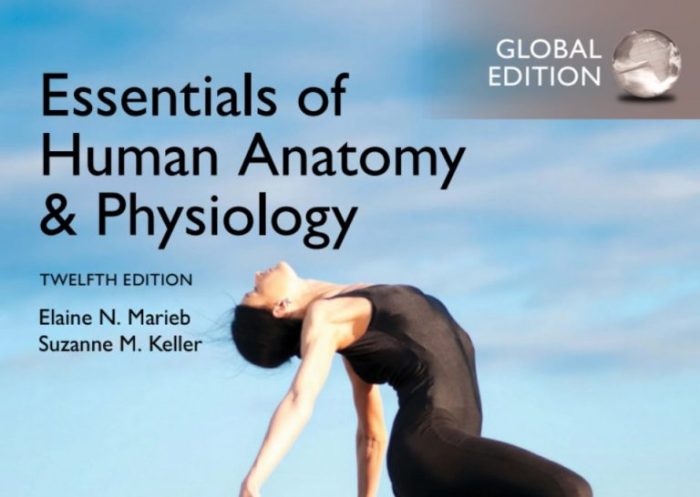Essentials of human anatomy and physiology eighth edition – Embarking on an exploration of Essentials of Human Anatomy and Physiology, Eighth Edition, readers will delve into a captivating journey through the complexities of the human body. This comprehensive resource provides an in-depth examination of the structure, function, and interconnections of the body’s systems, offering a profound understanding of human biology.
Through meticulously crafted explanations, detailed illustrations, and engaging case studies, this eighth edition empowers students with the knowledge and skills necessary to navigate the complexities of human anatomy and physiology. Its user-friendly design and accessible language make it an invaluable resource for both novice and experienced learners alike.
Introduction to Essentials of Human Anatomy and Physiology, Eighth Edition
Essentials of Human Anatomy and Physiology, Eighth Edition, by Elaine Marieb and Katja Hoehn, is a comprehensive textbook designed to provide students with a thorough understanding of the structure and function of the human body. Published in 2019 by Pearson Education, this book is widely used in introductory anatomy and physiology courses for healthcare professionals.
The book’s primary objective is to present a clear and concise overview of human anatomy and physiology, with a focus on clinical applications. It aims to help students develop a strong foundation in the subject matter and prepare them for success in their future careers.
Structure and Function of the Human Body
The human body is a complex and highly organized system, composed of various levels of organization. The basic unit of life is the cell, which forms tissues, which in turn form organs, and organs form organ systems. Each level of organization has its own specific structure and function.
Homeostasis is a critical concept in human anatomy and physiology. It refers to the body’s ability to maintain a stable internal environment despite external changes. Various regulatory mechanisms work together to maintain homeostasis, ensuring optimal conditions for cellular function.
The major organ systems of the body include the integumentary, skeletal, muscular, nervous, endocrine, cardiovascular, respiratory, digestive, urinary, and reproductive systems. Each system has its own unique set of organs and functions, working together to maintain the overall health and well-being of the body.
The Integumentary System

The integumentary system, consisting primarily of the skin, is the body’s largest organ. It serves as a protective barrier against pathogens, regulates body temperature, and plays a role in sensation and vitamin D synthesis.
The skin is composed of three layers: the epidermis, dermis, and hypodermis. The epidermis, the outermost layer, provides protection and contains specialized cells that produce keratin, a protein that helps maintain skin integrity.
The dermis, the middle layer, provides strength and elasticity to the skin. It contains blood vessels, nerves, hair follicles, and sweat glands.
The hypodermis, the innermost layer, consists of adipose tissue that insulates the body and provides cushioning.
The Skeletal System

The skeletal system provides support, protection, and movement for the body. It consists of bones, cartilage, and joints.
Bones are hard, mineralized tissues that form the framework of the body. They provide support and protection for organs and tissues, and they serve as levers for movement.
Cartilage is a flexible connective tissue that provides support and cushioning in various parts of the body, such as the joints, ears, and nose.
Joints are the points of contact between bones. They allow for movement and provide stability to the skeletal system.
The Muscular System
The muscular system is responsible for movement, posture, and heat production. It consists of three types of muscles: skeletal, smooth, and cardiac.
Skeletal muscles are attached to bones and are responsible for voluntary movements, such as walking, running, and lifting objects.
Smooth muscles are found in the walls of organs and blood vessels. They control involuntary movements, such as digestion and blood flow.
Cardiac muscle is found only in the heart. It contracts rhythmically to pump blood throughout the body.
The Nervous System: Essentials Of Human Anatomy And Physiology Eighth Edition

The nervous system controls and coordinates all bodily functions. It consists of the central nervous system (brain and spinal cord) and the peripheral nervous system (nerves and ganglia).
The central nervous system is the center of information processing and decision-making. The brain receives sensory information from the body and sends motor commands to control movement and other functions.
The peripheral nervous system transmits information between the central nervous system and the rest of the body. It consists of sensory nerves, which carry information from the body to the brain, and motor nerves, which carry commands from the brain to the body.
Answers to Common Questions
What is the significance of homeostasis in human physiology?
Homeostasis is crucial in maintaining a stable internal environment within the body, ensuring optimal function of cells, tissues, and organs. It involves intricate regulatory mechanisms that monitor and adjust physiological parameters, such as body temperature, pH, and blood glucose levels, to keep them within narrow ranges.
How does the skeletal system contribute to movement?
The skeletal system, composed of bones, joints, and muscles, provides the framework for movement. Muscles attach to bones and contract, generating forces that move bones and joints, enabling a wide range of voluntary and involuntary movements, from walking and running to breathing and digestion.
What is the role of the nervous system in regulating body functions?
The nervous system acts as the body’s control center, coordinating and regulating various functions. It receives sensory information from the environment and internal organs, processes it, and sends signals to muscles, glands, and other organs to initiate appropriate responses. The nervous system plays a vital role in maintaining homeostasis, controlling movement, and enabling cognitive functions.